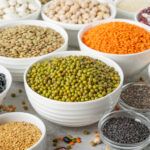A recent JRC study analysed trends in the nutritional quality of the packaged food and non-alcoholic beverage by assessing the level of sugars, salt, saturated fat and fibre of these products sold in supermarkets across Europe.
All EU Member States provide dietary recommendations for a healthy diet to their citizens. The foods offered in supermarkets need to be safe and are expected to be long lasting, convenient and regardless of their price, of good overall nutritional quality to facilitate adherence to the recommendations and promote health.
Hence, to meet these objectives, Member States and the EU are making efforts to improve the nutritional quality of the food offered to citizens. Our new JRC study assessed the extent to which efforts to improve the supply of healthier foods are succeeding.
The results of the analysis show some progress in Europe, although modest, towards the direction desired by public health proponents. In general, there is a small reduction in salt, sugars and saturated fat sold in packaged products to citizens.
Still, the amount of sugars and salt sold to Europeans citizens via this route remains a concern. Regrettably, there also is little evidence of desired increases in fibre content from the packaged foods on offer. Overall, more efforts are needed to achieve public health objectives.
How the study monitored products and consumers preferences
JRC scientists evaluated the nutritional quality of 23,000 products/brands of packaged foods and soft drinks sold across 22 European countries from 2015–2018. It covers on average 72% of the market for the four nutrients considered.
The analyses kept track of the nutritional composition and the market volumes of food products sold to citizens. The study assessed:
- the quantities of sugars, fat, salt and fibre that were sold through 14 packaged foods and drinks categories in 2018 vs. 2015,
- how much the content of these nutrients changed in the food and drink offers, taking into account also the market volume of the products, and
- the evolution of the combination of trends in nutrient content of products and their market sales, which reflect both market activities of producers and consumer preferences.
Which categories have improved and which still have room for improvement
The results show that the evolution is not yet fulfilling the public health nutrition objectives of reducing salt, sugars and saturated fat, as well as increasing fibre intakes.
For example, the changes in daily per capita sales in Europe suggest that few categories presented improvements in their nutritional content.
The only improvements seen for sugars were in Breakfast Cereals and Soft Drinks, for saturated fat in Processed Meat & Seafood, Sweet Biscuits and Baked Goods, for salt in Processed Meat & Seafood and Processed Fruit & Vegetable and for fibre in Savoury Snacks, Breakfast Cereals and Sweet Biscuits.
There are also significant differences between countries. For example, per capita sugars sales attributable to Soft Drinks did decrease to some extent in three on four of the analysed countries.
This may be attributable to producers’ efforts to reduce sugars and/or a relative market success of products with less, over those with more, sugars. On the other hand, reductions in per capita sales of salt from Processed Meat & Seafood were observed in only four countries.
Despite the progress observed in these categories, the overall nutrient amounts sold to European citizens through packaged food and soft drinks still remain close to the 2015 levels and are particularly concerning for sugars and salt.
In addition, the magnitudes of the estimated changes are low when compared to the targets set by established initiatives.
The estimated 3.3% reduction in the sugars weighted average – the main metric used by regulators to assess progress – between 2015 and 2018 lags far behind the 5-years’ (2015-2020) general benchmark of 10% reduction for added sugars.
The study’s estimated reductions of 4.4% and 2.1% on the weighted sales of saturated fats and salt are also respectively lower than the 5% and 16% 4-years’ target established by previous initiatives (considering as baseline-year 2008 for salt and 2012 for saturated fat).
A rather worrying outcome of the study is that the amounts of fibre sold across all product groups even decreased by 2.1% between 2015 and 2018.
Despite some improvements observed for those categories and nutrients, progress against public health objectives requires the attention of policymakers, industry and consumers. At EU level, the ‘Farm to Fork Strategy’ announced Commission proposals for a harmonised mandatory front-of-pack nutrition labelling scheme and for setting nutrient profiles to restrict the promotion (via nutrition or health claims) of foods high in fat, sugars and salt.
These initiatives, expected by the end of 2022, aim at empowering consumers to make healthy choices and at providing incentives to industry to improve their product’s nutritional profile.







Leave a Reply